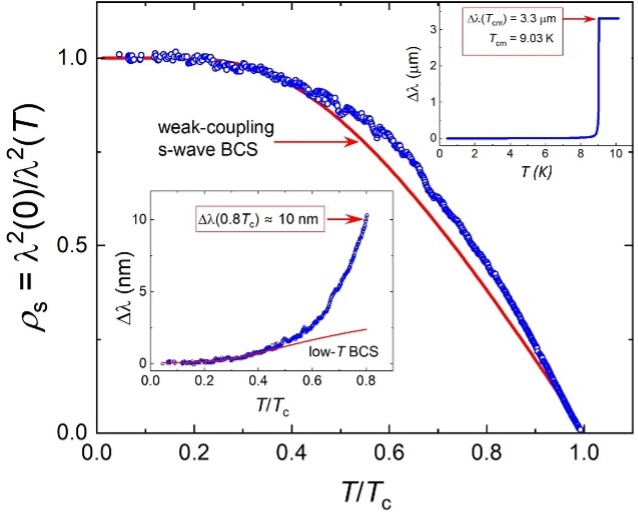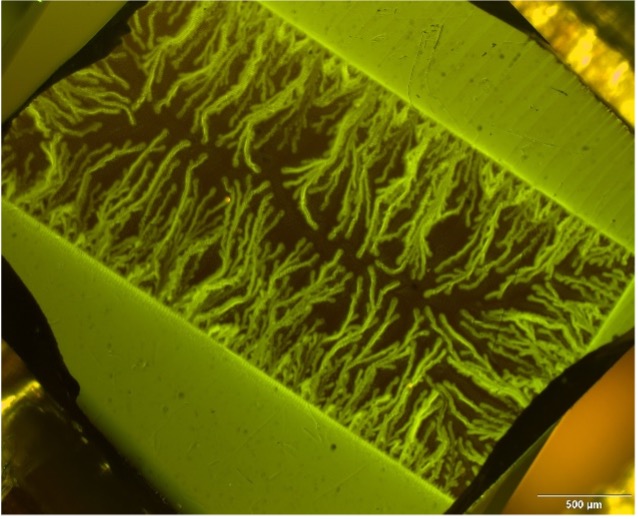Probing Superconducting State Properties of Nb Films used in Superconducting Qubits
Studying superconducting state properties reveals material imperfections limiting qubit coherence
The Science:
Nb films on silicon substrate used in superconducting qubits were studied using scanning and transmission electron microscopy, electrical transport, magnetization, the London penetration depth, and real-space real-time magneto-optical imaging. Although superconducting gap is clean in these films, performance in the magnetic field is complicated, exhibiting significantly irreversible behavior, and with insufficient heat channeling to a substrate leading thermomagnetic instabilities.


(Left) The normalized superfluid density obtained from the measured London penetration depth shown in the lower inset. The red solid curve is for isotropic weak coupling BSC theory. The upper inset shows the full transition temperature range and lower inset is at lower temperature up to 0.8 Tc. The red line in the lower inset is fitting with isotropic BSC theory and λ (T) at low temperature shows clean exponential attenuation of the weak magnetic field, indicating a clean superconducting gap.
(Right) Magneto-optical imaging of the magnetic flux penetration in a thin-film sample at T = 5 K at 100 Oe applied field. Thermomagnetic instabilities indicate an impeded heat flow between substrate and niobium.
The Impact:
This work suggest that highly granular structure of the sputtered thin films and insufficient heat conductance may present a significant challenge for qubit coherence. The discussed mitigation strategies should improve desired material properties and ultimately help to enhance qubit coherence times.
Summary:
Nb thin films are one of the leading materials of choice for superconducting transmon devices. To improve the performance superconducting qubits, it is necessary to understand material properties especially in the superconducting state. In this work, we use various experimental techniques to study electrical transport, upper and third critical fields, magnetization, quasiparticle spectroscopy, and spatial distribution of the magnetic induction in Nb thin films magnetron-sputtered on silicon substrate. Overall, the films have excellent superconducting properties with high transition temperature, Tc = 9.35 K and clean superconducting gap. Some issues are revealed in their behavior in a magnetic field. While during normal transmon operation the magnetic fields involved are very small, our study helps to identify the otherwise invisible issues impeding uniform flow of a supercurrent. The studied films demonstrate highly irreversible behavior in a magnetic field. The insufficient heat channeling from niobium film to silicone substrate is identified from the observation of thermomagnetic instabilities – sudden dendritic flux penetration in the process akin to lightning strikes. From the electrical transport measurements we concluded that usually used RRR=R(300)/R(Tc) criterion is not a good metric to characterize scattering in granular films. The significant contribution from the grain boundaries renders this parameter not particularly useful. Instead, measurements of the upper critical field, determined by the in-grain physics, offer a better criterion to access film purity. From these measurements we extract dimensionless scattering rate of about 2.8, which places these fims in the dirty limit (in the clean limit this parameter is significantly less than 1).
We discuss strategies to mitigate the observed points of concern. One of our suggestions to run the transmon in liquid helium to ensure prompt heat transfer has recently been independently implemented by the UK-based group.
Contact:
Ruslan Prozorov – prozorov@ameslab.gov
Focus Area:
Materials for 2D and 3D Quantum Devices
Institutions:
Ames National Laboratory, Rigetti Computing, Louisiana State University
Citation:
K. R. Joshi, S. Ghimire, M. A. Tanatar, A. Datta, J.-S. Oh, L. Zhou, C. J. Kopas, J. Marshall, J. Y. Mutus, J. Slaughter, M. J. Kramer, J. A. Sauls, and R. Prozorov, Quasiparticle Spectroscopy, Transport, and Magnetic Properties of Nb Films Used in Superconducting Qubits, Phys. Rev. Appl. 20, 024031 (2023). https://doi.org/10.1103/PhysRevApplied.20.024031
Also, see: M. A. Tanatar, D. Torsello, K. R. Joshi, S. Ghimire, C. J. Kopas, J. Marshall, J. Y. Mutus, G. Ghigo, M. Zarea, J. A. Sauls, and R. Prozorov, Anisotropic Superconductivity of Niobium Based on Its Response to Nonmagnetic Disorder, Phys. Rev. B 106, 224511 (2022) https://doi.org/10.1103/PhysRevB.106.224511.
Funding Acknowledgement:
This work was supported by the U.S. Department of Energy, Office of Science, National Quantum Information Science Research Centers, Superconducting Quantum Materials and Systems Center (SQMS) under Contract No. DE-AC02-07CH11359. The research was performed at the Ames National Laboratory, operated for the U.S. DOE by Iowa State University under Contract No. DE-AC02-07CH11358.
